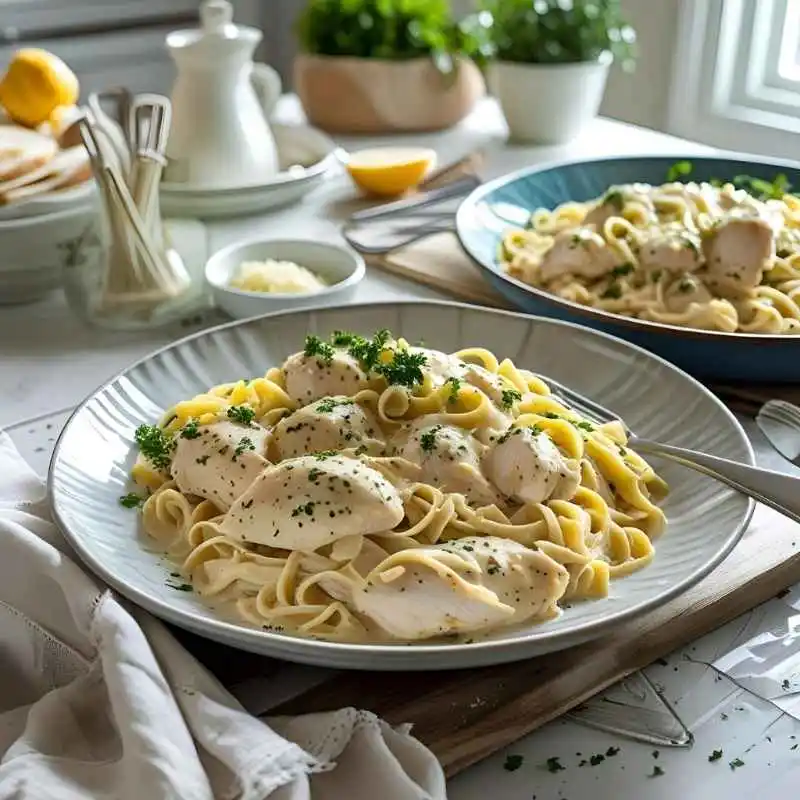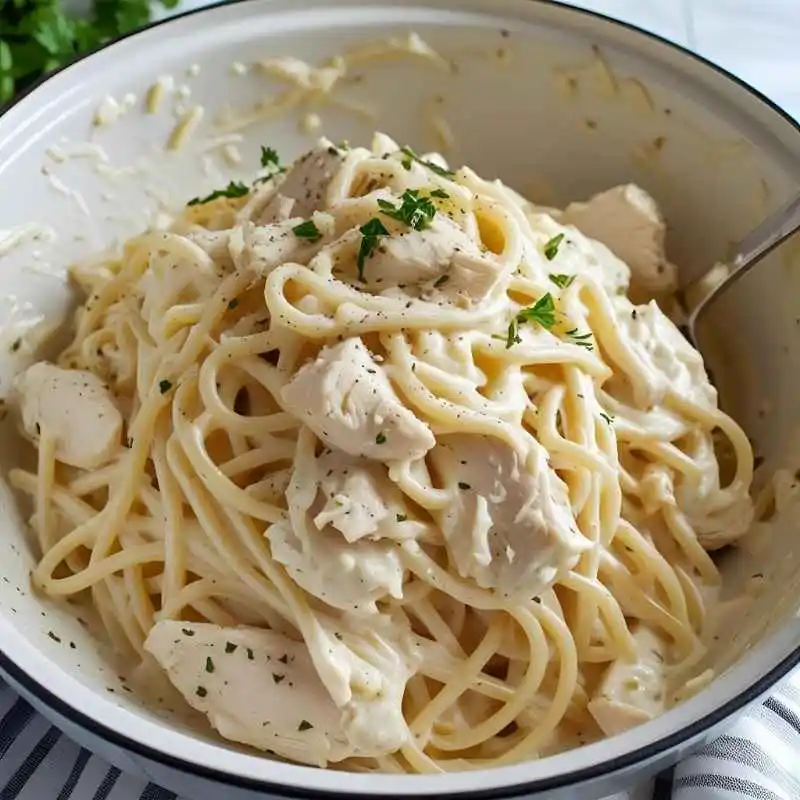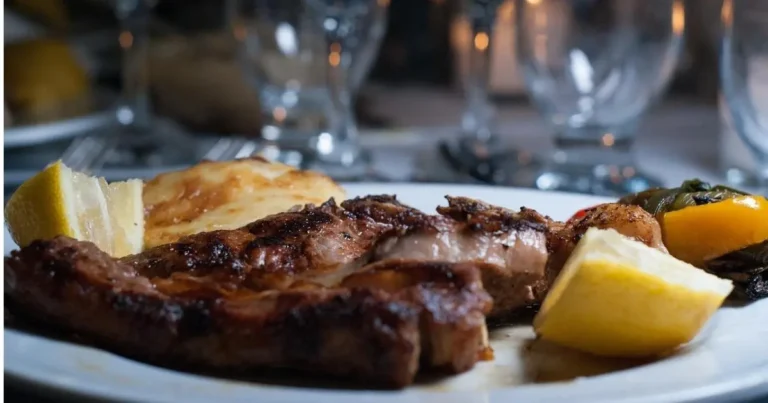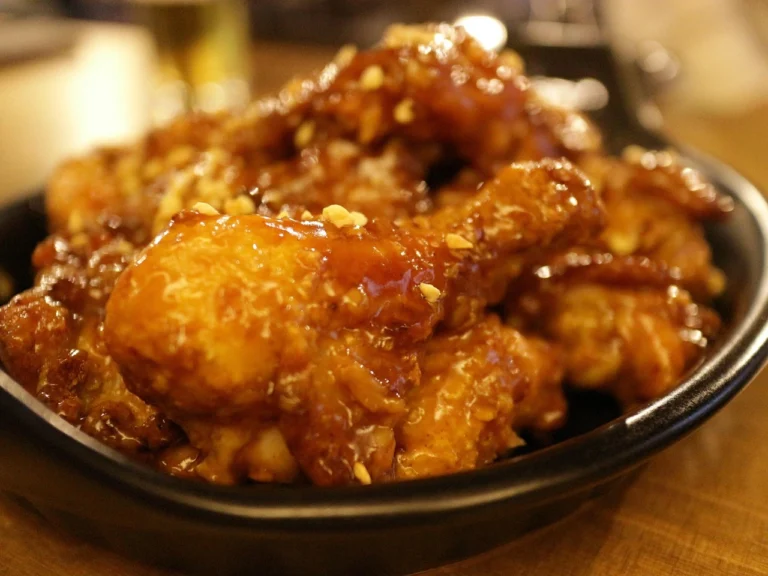How to Make Chicken Alfredo Recipec: Step-by-Step Recipe Guide
Table of Contents
Are you craving a rich and creamy pasta dish that’s easy to make? You’re in the right place! Chicken Alfredo is a classic Italian-American recipe that can be prepared in no time.
To make this delicious dish, you’ll need a few simple ingredients, including fettuccine pasta, parmesan cheese, and a protein of your choice. In this guide, we’ll walk you through the steps to create a mouth-watering Alfredo sauce from scratch.
By following our step-by-step instructions, you’ll be able to create a restaurant-quality chicken alfredo recipe in the comfort of your own kitchen.
Key Takeaways
- Learn how to make a creamy Alfredo sauce from scratch.
- Discover the secrets to cooking perfect fettuccine pasta.
- Find out how to prepare a delicious and protein-rich chicken alfredo dish.
- Get tips on customizing your recipe to suit your taste preferences.
- Understand the importance of using high-quality ingredients.
The Classic Chicken Alfredo Recipe: An Overview
Chicken Alfredo, a staple in many restaurants, has a fascinating history that begins in Italy. This dish, known for its rich and creamy sauce served over fettuccine pasta, has become a favorite among pasta lovers worldwide. In this section, we’ll explore the origins of Chicken Alfredo, understand why this recipe is a crowd-pleaser, and outline what you can expect to learn from this guide.
History of Chicken Alfredo
Chicken Alfredo’s origins date back to the early 20th century in Italy, where it was created by Alfredo Di Lelio. The original recipe, known as “Fettuccine al Burro,” was a simple yet rich dish made with fettuccine, butter, and Parmesan cheese. Over time, the recipe evolved, and the addition of chicken transformed it into the Chicken Alfredo we know today. This evolution has made it a versatile dish that can be adapted to various tastes.
Why This Recipe Works
This Chicken Alfredo recipe works because it strikes a perfect balance between flavors and textures. The combination of tender chicken, al dente fettuccine, and a creamy Alfredo sauce creates a harmonious dish that’s both satisfying and delicious. By following this guide, you’ll learn how to make alfredo pasta that’s sure to impress.
What to Expect From This Guide
In this comprehensive guide, you’ll learn the intricacies of preparing fettuccine chicken alfredo sauce, from selecting the right ingredients to cooking the perfect pasta. We’ll walk you through each step, providing tips and tricks to ensure your Chicken Alfredo turns out perfectly. Whether you’re a novice cook or an experienced chef, this guide is designed to help you create a mouth-watering dish that’s sure to become a staple in your kitchen.
Essential Ingredients for Perfect Chicken Alfredo
Creating the perfect Chicken Alfredo begins with selecting the right ingredients. The quality of your dish depends on a few crucial elements: the chicken, the pasta, and the Alfredo sauce. Understanding the role of each component is vital to crafting a delicious and authentic Italian-American dish.
Chicken Selection and Preparation
For Chicken Alfredo, it’s best to use boneless, skinless chicken breasts. They provide a lean protein source that cooks evenly and quickly. When selecting chicken, look for breasts that are firm and have a pinkish color, indicating freshness. To prepare the chicken, you’ll need to season it appropriately. Seasoning the chicken with salt, pepper, and Italian herbs like thyme and basil will enhance its flavor. You can also marinate the chicken in a mixture of olive oil, garlic, and lemon juice to add depth. Learning how to season chicken for Alfredo effectively is key to a flavorful dish.
Pasta Options for Alfredo
The traditional pasta choice for Alfredo is fettuccine, but there are other options you can consider.
Traditional Fettuccine
Fettuccine is a flat, wide noodle made from egg and flour. Its smooth surface and texture make it an ideal candidate for holding onto the creamy Alfredo sauce. Fettuccine’s ability to cling to the sauce is what makes it a classic pairing.
Alternative Pasta Shapes
If you don’t have fettuccine or prefer a different texture, you can use other pasta shapes. Pappardelle, with its similar flat shape, works well, as does spaghetti or even penne in a pinch. The key is to choose a pasta that will hold the sauce effectively.
Alfredo Sauce Components
The Alfredo sauce is what gives the dish its signature creaminess. The core ingredients of a traditional Alfredo sauce include butter, heavy cream, Parmesan cheese, and garlic. Using high-quality Parmesan cheese is crucial, as it provides a salty, nutty flavor that is essential to the sauce. To make a rich and creamy fettuccine chicken Alfredo sauce, it’s essential to balance these ingredients correctly. The sauce should be smooth and creamy, coating the pasta evenly.
By focusing on these essential ingredients and understanding their roles, you can create a Chicken Alfredo that is both authentic and delicious.
Kitchen Equipment You’ll Need
tag, adhering to the specified requirements and guidelines.
Preparing Your Ingredients
The key to a great Chicken Alfredo lies in the preparation of its ingredients. Proper preparation ensures that all components of the dish are ready to be cooked or combined at the right time, making the cooking process smoother and more efficient.
How to Season Chicken for Alfredo
Seasoning the chicken is a critical step that enhances the flavor of your Chicken Alfredo. To season your chicken effectively, you need to understand the basics of herb and spice combinations and how to marinate the chicken.
Herb and Spice Combinations
For Chicken Alfredo, a blend of Italian herbs such as basil, oregano, and thyme works well. You can also add some garlic powder and onion powder to give it a richer flavor. Mix these herbs and spices with salt and pepper to create a seasoning blend that will enhance the chicken’s natural taste.
Marinating Tips
Marinating the chicken can add an extra layer of flavor. Use a mixture of olive oil, lemon juice, and your chosen herbs and spices. Make sure to marinate the chicken for at least 30 minutes, though marinating it for a few hours or overnight can yield even better results.
Preparing Other Components
Apart from seasoning the chicken, you also need to prepare other components such as fettuccine pasta and Alfredo sauce. Ensure that your pasta is fresh and stored properly. For the Alfredo sauce, have all the necessary ingredients like butter, cream, Parmesan cheese, and garlic ready to be used.
Cooking the Perfect Chicken for Alfredo
Perfectly cooked chicken is the backbone of a great Chicken Alfredo recipe. To achieve this, you need to focus on the cooking method and technique. The goal is to cook the chicken until it’s tender, juicy, and just done.
Sautéing Method
Sautéing is a quick and effective way to cook chicken for Alfredo. Start by heating a skillet over medium-high heat and adding a small amount of oil. Once the oil is hot, add your seasoned chicken breasts. Cook for about 5-7 minutes on each side, or until the chicken reaches an internal temperature of 165°F. Let it rest for a few minutes before slicing.
Grilling Alternative
If you prefer a grilled flavor, you can cook your chicken on a preheated grill. Brush the grates with oil to prevent sticking, then place your chicken on the grill. Cook for about 5-7 minutes per side, or until the chicken is cooked through. Grilling adds a smoky flavor that complements the creamy Alfredo sauce.
How to Tell When Chicken is Done
The safest way to check if your chicken is done is by using a meat thermometer. The internal temperature should reach 165°F. You can also check by cutting into the thickest part of the breast; if it’s white and the juices run clear, it’s cooked through.
Slicing Chicken for Serving
Once your chicken is cooked and rested, it’s time to slice it. Use a sharp knife to slice the chicken into thin strips. This ensures that the chicken distributes evenly throughout the Alfredo dish, providing a tender bite every time.
By following these guidelines, you’ll be able to cook chicken that’s not only delicious but also safe to eat. The key is to not overcook the chicken, keeping it juicy and tender.
Creating a Creamy Fettuccine Chicken Alfredo Sauce
A great fettuccine chicken alfredo sauce is the foundation upon which a delicious meal is built, and we’re here to guide you through creating it. The sauce is what brings the dish together, coating the fettuccine and chicken in a rich, creamy layer that’s both indulgent and satisfying.
Traditional Alfredo Sauce Technique


The traditional Alfredo sauce technique involves just a few ingredients: butter, Parmesan cheese, and heavy cream. The simplicity is part of its charm, but it’s also where the challenge lies. To make a truly great Alfredo sauce, you need to balance these ingredients perfectly.
Start by melting butter in a saucepan over medium heat. Once melted, add heavy cream and bring the mixture to a simmer. Let it cook for a few minutes until it starts to reduce slightly, which will help thicken the sauce. Then, gradually add Parmesan cheese, stirring constantly to avoid lumps. The key is to add the cheese slowly and stir continuously, ensuring it melts smoothly into the sauce.
Tip: Use high-quality Parmesan cheese for the best flavor. Freshly grated cheese is ideal, as it melts better and has a more vibrant taste than pre-packaged grated cheese.
Common Sauce Mistakes to Avoid
Even with a simple recipe, there are several pitfalls to watch out for when making fettuccine chicken alfredo sauce. One of the most common issues is the sauce breaking or separating, which can happen if the cheese is added too quickly or the sauce is overheated.
Fixing Broken or Separated Sauce
If your sauce does break, don’t panic. You can often rescue it by whisking in a little more heavy cream or butter. Start with a small amount, whisking vigorously, and add more as needed until the sauce comes back together.
Adjusting Thickness
The ideal consistency for Alfredo sauce is creamy but still pourable. If your sauce becomes too thick, you can thin it out with a bit more heavy cream. Conversely, if it’s too thin, simmering it for a few more minutes will help it reduce and thicken.
Making the Sauce Ahead of Time
One of the conveniences of Alfredo sauce is that it can be made ahead of time. Prepare the sauce as instructed, then let it cool before refrigerating or freezing it. When you’re ready to serve, gently reheat the sauce over low heat, adding a little cream or butter if needed to restore its creamy texture.
By following these tips and techniques, you’ll be well on your way to creating a fettuccine chicken alfredo sauce that’s sure to impress. Whether you’re cooking for a special occasion or just a weeknight dinner, a great Alfredo sauce can elevate the entire meal.
Cooking Pasta to Al Dente Perfection
To make outstanding Chicken Alfredo, you need to master the art of cooking pasta al dente. Al dente, which is Italian for “to the tooth,” refers to pasta that is cooked until it still has a bit of bite or chew. This texture is crucial because it provides a satisfying mouthfeel and helps the pasta hold onto the Alfredo sauce better.
Pasta Cooking Techniques
Cooking pasta al dente requires attention to detail. Start by bringing a large pot of salted water to a boil. The general rule is to use about 4-6 quarts of water for every pound of pasta, and add 1-2 tablespoons of salt. Once boiling, add your fettuccine pasta and stir gently to prevent it from sticking together. Monitor the cooking time closely, as it usually ranges between 8-12 minutes depending on the pasta brand and type. Stir occasionally to prevent sticking.
To check if your pasta is al dente, start tasting it a minute or two before the recommended cooking time is up. It should still have a slight firmness in the center. If it’s too hard, it’s undercooked; if it’s too soft, it’s overcooked.
Timing Your Pasta with the Sauce
Timing is everything when it comes to combining pasta with Alfredo sauce. Ideally, you want to cook your pasta so that it finishes cooking around the same time your sauce is ready. This ensures that the pasta and sauce can be combined while both are hot, resulting in a harmonious blend of flavors and textures.
Reserving Pasta Water – The Secret Ingredient
Before draining your pasta, reserve some of the pasta water. This starchy water is a secret ingredient that can help adjust the consistency of your Alfredo sauce. If the sauce becomes too thick, adding a bit of pasta water can thin it out to the perfect creamy consistency.
| Pasta Type | Recommended Cooking Time | Al Dente Check Time |
|---|---|---|
| Fettuccine | 8-12 minutes | 6-7 minutes |
| Spaghetti | 7-11 minutes | 5-6 minutes |
| Penne | 8-12 minutes | 6-7 minutes |
Assembling and Serving Your Chicken Alfredo
With your chicken cooked, pasta al dente, and Alfredo sauce ready, it’s time to bring everything together. Assembling your chicken Alfredo is a straightforward process that requires some finesse to achieve a harmonious balance of flavors and textures.
Combining Pasta, Sauce, and Chicken
To combine your pasta, sauce, and chicken effectively, start by adding the cooked fettuccine to the Alfredo sauce. Toss the pasta in the sauce until it’s well coated, adding some reserved pasta water if the sauce seems too thick. Then, add your cooked chicken to the pasta and sauce, tossing everything together until the chicken is evenly distributed.
Garnishing and Presentation Tips
Presentation matters when serving your chicken Alfredo. Consider garnishing with chopped parsley or basil for a fresh look. You can also sprinkle some grated Parmesan cheese on top for added flavor and texture. Serving the dish hot, straight from the kitchen, ensures the best flavor and texture.
Side Dishes That Complement Chicken Alfredo
While chicken Alfredo is a satisfying meal on its own, it can be complemented with side dishes to round out the meal. A simple green salad or some garlic bread can provide a nice contrast to the rich pasta. Roasted vegetables like broccoli or asparagus are also healthy and flavorful options that complement the dish well.
| Side Dish | Description |
|---|---|
| Green Salad | A simple mix of greens with a light vinaigrette dressing. |
| Garlic Bread | Toasted bread spread with garlic butter. |
| Roasted Broccoli | Broccoli florets roasted with olive oil, salt, and pepper. |
Conclusion: Enjoying Your Homemade Chicken Alfredo
Now that you’ve mastered the art of making chicken alfredo, it’s time to savor the delicious results. Your homemade fettuccine chicken alfredo sauce is sure to impress family and friends alike. The rich, creamy sauce and tender chicken, combined with perfectly cooked pasta, create a dish that’s both comforting and sophisticated.
As you enjoy your homemade chicken alfredo, remember the key steps that made it possible: carefully selecting ingredients, cooking the chicken to perfection, and crafting a smooth fettuccine chicken alfredo sauce. By following these steps, you’ve created a truly special meal that’s sure to become a favorite.
Whether you’re cooking for a special occasion or simply a weeknight dinner, your homemade chicken alfredo is sure to please. So go ahead, take a bite, and enjoy the fruits of your labor – you’ve earned it after learning how to make chicken alfredo to perfection.
FAQ
What is the best type of pasta to use for chicken alfredo?
Fettuccine is the traditional pasta choice for chicken alfredo due to its flat, wide noodles that hold onto the creamy alfredo sauce well. However, you can also use other pasta shapes like pappardelle or linguine as alternatives.
How do you season chicken for alfredo?
To season chicken for alfredo, you can use a mix of herbs and spices such as salt, pepper, garlic powder, and Italian seasoning. Marinating the chicken in a mixture that includes olive oil, lemon juice, and your choice of herbs can also enhance the flavor.
What are the essential components of alfredo sauce?
The essential components of alfredo sauce are butter, heavy cream, Parmesan cheese, and garlic. The sauce is typically made by melting butter, then adding heavy cream and Parmesan cheese, stirring until the cheese is melted and the sauce is smooth.
How do you prevent alfredo sauce from separating?
To prevent alfredo sauce from separating, it’s crucial to stir the sauce constantly over low heat, especially when adding the Parmesan cheese. You can also add a little pasta water to the sauce to help it emulsify and maintain its creamy texture.
Can you make alfredo sauce ahead of time?
Yes, you can make alfredo sauce ahead of time. It’s best to make it just before serving, but you can prepare it a few hours in advance. Reheat the sauce gently over low heat, stirring constantly, and add a little pasta water if needed to achieve the right consistency.
How do you cook pasta to al dente perfection?
To cook pasta to al dente perfection, boil it in salted water until it’s tender but still has a bit of bite or chew. Check the pasta frequently towards the end of the cooking time, and reserve some pasta water before draining the rest.
What are some common mistakes to avoid when making chicken alfredo?
Common mistakes to avoid include overcooking the pasta or chicken, not reserving enough pasta water, and not stirring the alfredo sauce constantly, which can cause it to separate or become too thick.
Enjoyed the recipes? We’d love to hear your honest thoughts!😊
There are no reviews yet. Be the first one to write one.







